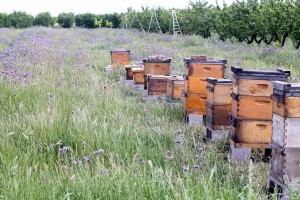PEST CONTROL
by Lael Gerhart
Biological Control is defined as the reduction of pest populations by natural enemies and usually involves human intervention. If properly managed, biological control can be a safe and effective means to reduce the pressure of insect pests, weeds, and diseases. Many organic farmers rely on biological control to keep their crops happy and healthy. There are three types of biological control: conservation, classical biological control, and augmentation.
Conservation Control is one of the most important forms of control for organic growers. CC is a preemptive method of control where growers try to encourage and conserve natural enemy populations in the farm habitat in order to try and keep pest populations low. Earwigs are a favorite snack of birds. In last week’s newsletter we talked about how we leave our weed cuttings in the tree rows to provide organic matter for the soil. Leaving these weed cuttings in the rows also provides nest-building materials for our friends, the earwig eating birds.
Unfortunately, pest populations sometimes become too high for conservation methods to control, and Classical Biological Control is employed. CBC is most commonly used to control a pest that is introduced to an area without its natural enemies, but is also used for native pests. Without the presence of natural enemies, “exotic” pests can wreak havoc on food crops, and native habitats as well, in the form of invasive weeds.
CBC identifies, collects, quarantines, and then releases natural enemies of the pest into the affected habitat. There are many successful examples of reducing pest pressure due to CBC. European corn borer populations have been greatly reduced due to the introduction of a small predatory wasp. Of course, there have been some devastating failures in instances when the introduced natural enemy does not only affect the targeted pest, but native species as well.Our application of spinocad falls under CBC because we are introducing something foreign into our farm habitat. Bacteria, viruses, and fungi formulated for commercial use are referred to as bio-insecticides or microbial insecticides. When applied they cause diseases in target pests. Beneficial insects are not usually affected because of the product’s specificity.
Of course we do everything we can to keep pests at bay on the farm so as not to need to apply anything, soil derived or not. This leads us to the last form of biological control–augmentation. Augmentation often refers to the supplemental release of natural enemies. The release of lady beetles (aka lady bugs) in vegetable crops is an example of augmentation. The modification of a cropping system to favor beneficial insects is another form of augmentation. At Frog Hollow Farm, we have created habitats to increase the number of beneficial insects and pollinators (bees) on the farm. Over two dozen varieties of native plants in the form of trees, shrubs, flowers, and groundcover are used throughout the farm in hedgerows, orchard rows, and established meadow areas to provide shelter and food for our insect and bird friends.

 Follow
Follow


